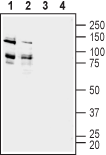Overview
- Peptide (C)HNDDAKTGITLSGNG, corresponding to amino acid residues 715-729 of mouse ADAM22 (Accession Q9R1V6). Extracellular, N-terminus.
- Mouse and rat brain membranes (1:200-1:1000).
 Western blot analysis of rat (lanes 1 and 3) and mouse (lanes 2 and 4) brain membranes:1,2. Anti-ADAM22 (extracellular) Antibody (#ANR-120), (1:200).
Western blot analysis of rat (lanes 1 and 3) and mouse (lanes 2 and 4) brain membranes:1,2. Anti-ADAM22 (extracellular) Antibody (#ANR-120), (1:200).
3,4. Anti-ADAM22 (extracellular) Antibody, preincubated with ADAM22 (extracellular) Blocking Peptide (#BLP-NR120).
- Mouse brain sections (1:200).
ADAMs (a disintegrin and metalloproteinases) are multi-domain transmembrane glycoproteins with diverse roles in physiology and disease. Notably, 8 of 21 ADAMs lack functional metalloproteinase domains and are implicated in protein-protein interactions instead of membrane protein ectodomain shedding.
ADAM22 is a non-proteinase which acts as a post synaptic receptor for the secreted neurotransmission modulator LGI-1 at neural synapses. ADAM22 is a compact four-leaf clover with the metalloproteinase-like domain (Domain M) held in the concave face of a rigid module formed by the disintegrin (Domain D), cysteine-rich (Domain C), and epidermal growth factor-like domains (Domain E). The largest domain in the four-leaf clover, domain M, is distal to the cell membrane. Following domain M, domain D and domain C zigzag to domain E in a compact, but not extended fashion. A 15-amino acid linker, leads the C terminus of domain E to the membrane. The loss of metalloproteinase activity is ensured by the absence of critical catalytic residues, the filling of the substrate groove, and the steric hindrance by the cysteine-rich domain. The extracellular domain of ADAM22 interacts with LGI-1, whereas its cytoplasmic PDZ-binding motif recruits PSD-95. The link of ADAM22 and LGI-1 to AMPA receptors establishes their roles in glutamate neurotransmission1.
Mutations that impair LGI-1 binding to ADAM22 are implicated in the pathogenesis of Autosomal dominant lateral temporal epilepsy (ADTLE), a focal epilepsy syndrome characterized by focal seizures with prominent auditory or aphasic symptoms, normal magnetic resonance imaging, and usually benign evolution2.
